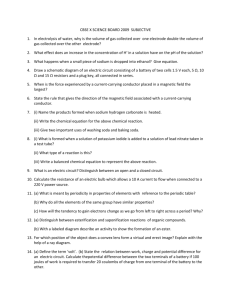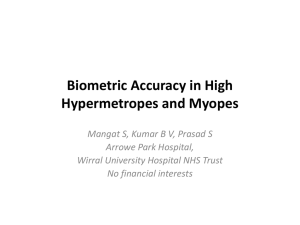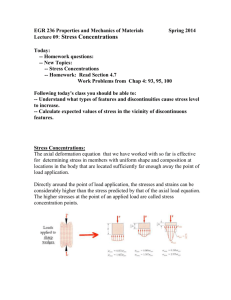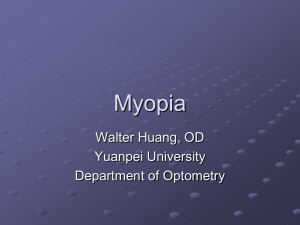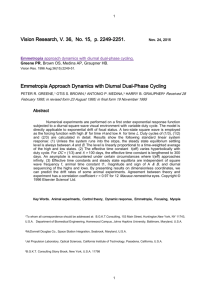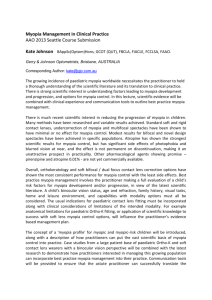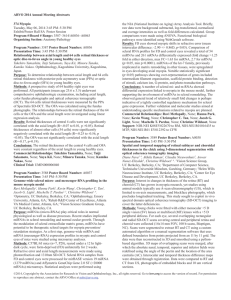A COMPARATIVE STUDY IN AXIAL LENGTH OF EYE BETWEEN
advertisement
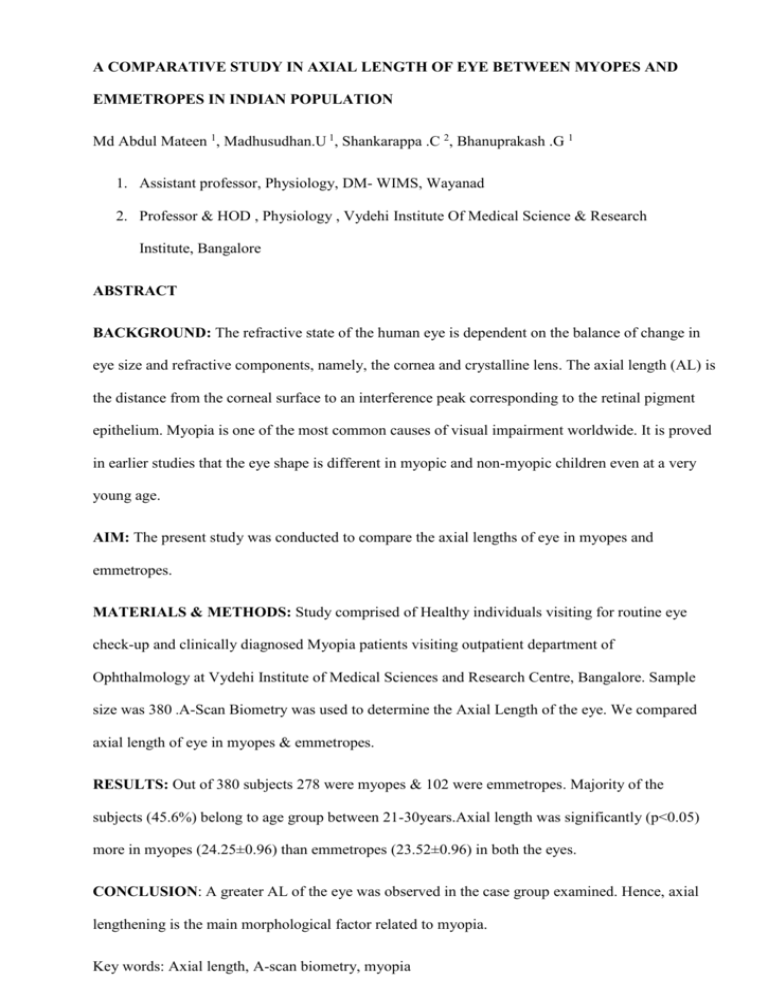
A COMPARATIVE STUDY IN AXIAL LENGTH OF EYE BETWEEN MYOPES AND
EMMETROPES IN INDIAN POPULATION
Md Abdul Mateen 1, Madhusudhan.U 1, Shankarappa .C 2, Bhanuprakash .G 1
1. Assistant professor, Physiology, DM- WIMS, Wayanad
2. Professor & HOD , Physiology , Vydehi Institute Of Medical Science & Research
Institute, Bangalore
ABSTRACT
BACKGROUND: The refractive state of the human eye is dependent on the balance of change in
eye size and refractive components, namely, the cornea and crystalline lens. The axial length (AL) is
the distance from the corneal surface to an interference peak corresponding to the retinal pigment
epithelium. Myopia is one of the most common causes of visual impairment worldwide. It is proved
in earlier studies that the eye shape is different in myopic and non-myopic children even at a very
young age.
AIM: The present study was conducted to compare the axial lengths of eye in myopes and
emmetropes.
MATERIALS & METHODS: Study comprised of Healthy individuals visiting for routine eye
check-up and clinically diagnosed Myopia patients visiting outpatient department of
Ophthalmology at Vydehi Institute of Medical Sciences and Research Centre, Bangalore. Sample
size was 380 .A-Scan Biometry was used to determine the Axial Length of the eye. We compared
axial length of eye in myopes & emmetropes.
RESULTS: Out of 380 subjects 278 were myopes & 102 were emmetropes. Majority of the
subjects (45.6%) belong to age group between 21-30years.Axial length was significantly (p<0.05)
more in myopes (24.25±0.96) than emmetropes (23.52±0.96) in both the eyes.
CONCLUSION: A greater AL of the eye was observed in the case group examined. Hence, axial
lengthening is the main morphological factor related to myopia.
Key words: Axial length, A-scan biometry, myopia
Dr Md Abdul Mateen , Assistant professor , Physiology ,DM-WIMS , dr.matynne@gmail.com
INTRODUCTION
Myopia or Short Sightedness is a common cause of reversible in India with a prevalence of 27%.
Increase in Axial Length (distance between the anterior and posterior poles of the eye) and
decrease in radius of Curvature of Cornea are considered as the two most significant factors
associated with Myopia.
Several authors have proposed classifying myopia into two main categories according to the age
of its appearance as juvenile-onset myopia and adult-onset myopia. In both myopia types, it has
been demonstrated that an increase in the axial length (AL) of the eyeball is the main factor
related to its progression in children 1, 2, 3 and adults 4, 5, 6. Juvenile myopia has been also attributed
a genetic cause because several studies have linked its development with a familial history of the
disease.
Several studies have demonstrated relationship between corneal radius (CR), & Axial length
especially in emmetropes. We know that during emmetropization, an increased AL of the eye will
be counteracted by an increase in the CR to maintain emmetropia. Paradoxically, other authors
have found that the most myopic subjects, those with greatest ALs, have smaller corneal radii7, 8, 9.
Other authors find no relationship between AL and CR in any category of myopes.10, 11
So the present study was conducted to compare axial length of eye in myopes & emmetropes
AIM
To compare the axial lengths of eye in myopes and emmetropes.
MATERIALS & METHODS
Study Area: Vydehi Institute of Medical Sciences and Research Centre, Bangalore.
Study Design: Comparative clinical study
Study Sample: Comprised of Healthy individuals visiting for routine eye check-up and clinically
diagnosed Myopia patients visiting outpatient department of Ophthalmology at Vydehi Institute of
Medical Sciences and Research Centre, Bangalore.
Group A {Controls} – Emmetropic men and Women
Group B {Cases} - Myopia patients attending the Ophthalmology Department
The Sample Size was 380 including the control and case groups.
A-SCAN BIOMETRY will be used to determine the Axial Length of the eye.
In A-scan biometry, one thin, parallel sound beam is emitted from the probe tip at its given
frequency of approximately 10 MHz, with an echo bouncing back into the probe tip as the sound
beam strikes each interface. An interface is the junction between any two media of different
densities and velocities, which, in the eye, include the anterior corneal surface, the
aqueous/anterior lens surface, the posterior lens capsule/anterior vitreous, the posterior
vitreous/retinal surface, and the choroid/anterior scleral surface. Ethical clearance was obtained
from the university.
Method of Analysis: The filled pre-structured Performa and the details of the clinical
examination were numbered; the responses were coded and entered on a Microsoft Excel 2007
spread sheet and analysed by statistical methods like mean, standard deviation, T- test and ANOVA
using SPSS 10.
RESULTS
Out of 380 subjects 278 were myopes & 102 were emmetropes. Majority of the subjects (45.6%)
belong to age group between 21-30years (TABLE 1). Axial length was significantly (p<0.05)
more in myopes (24.25±0.96) than emmetropes (23.52±0.96) in both the eyes (TABLE 2).
Majority (52.8%) of the subjects were females (TABLE 3). There was a significant correlation in
right and left refractive errors (TABLE 4) in case and control group (P < 0.001). Correlation was
found high in the case of refractive error (Spherical) and axial length values in the whole
population (r2 = 0.349) (Fig 1).
DISCUSSION
This was a comparative study in axial length of eye between myopes and emmetropes, which was
done on the healthy individuals and clinically diagnosed Myopia patients.
In this study the subjects were divided in to case and control groups. In this study out of 278
subjects in the control group, 127 were males whereas 150 were females. The control group
consisted of equal number of males and females out of 102 subjects (TABLE 1). Maximum
percentage of myopes was recorded in the age group between 31-40 years in the case and control
groups.
Myopia in humans is a very common condition and has typically been associated to age and
genetic factors (familiar antecedents, ethnic heritage…) as well as environmental factors (near
work, social status, occupation…).
The main finding of the study was that the axial length of eye in myopes is significantly more than
emmetropes. The data on the refractive error of the subjects in the present study revealed positive
corelation between AL and refraction in two groups mainly in the case group.
The data on the refractive error of the subjects in the present study revealed positive correlation
with axial length. It may be assumed that when the AL exceeds a certain value, the cornea could
show a smaller radius. Thus, it is highly probable that axial lengthening could be initially
compensated by the increase in CR, preserving emmetropia
Myopia will appear when, for any genetic and/or environmental reason, axial growth is excessive
and cannot be sufficiently compensated by the increase in CR. This theory is in line with
hypotheses put forward by Van Alphen 12.
CONCLUSION
A greater AL of the eye was observed in the case group examined, irrespective of other factors.
Hence, axial lengthening is the main morphological factor related to myopia.
REFERENCES
1. Tan N, Saw SM, Chee D, Lam DS, Cheng HM, Rajan U, Chew SJ. Non-linear progression
of myopia during a school year. Invest Ophthalmol Vis Sci 1998; 39:S280.
2. Saw SM, Katz J, Schein OD, Chew SJ, and Chan TK. Epidemiology of myopia. Epidemiol
Rev 1996;18:175–87
3. Wallman J, McFadden S. Monkey eyes grow into focus. Nat Med 1995; 1:737–9.
4. Teasdale TW, Goldschmidt E. Myopia and its relationship to education, intelligence and
height. Preliminary results from an on-going study of Danish draftees. Acta Ophthalmol
Suppl 1988; 185:41–3.
5. Hung LF, Crawford ML, Smith EL, 3rd. Spectacle lenses alter eye growth and the
refractive status of young monkeys. Nat Med 1995; 1:761–5.
6. Richler A, Bear JC. Refraction, nearwork and education. A population study in
Newfoundland. Acta Ophthalmol (Copenh) 1980; 58: 468–78.
7. Delmarcelle Y, Francois J, Goes F, Collignon-Brach J, Luyckx-Bacus J, Verbraeken H.
Biometrie oculaire Clinique Oculometrie). Bull Soc Belge Ophtalmol 1976; 172.
8. De Luise VP, Anderson DR. Primary infantile glaucoma (congenital glaucoma). Surv
Ophthalmol 1983; 28: 1-19
9. Sampaolesi R, Caruso R. Ocular echometry in the diagnosis of congenital glaucoma. Arch
Ophthalmol 1982; 100: 574-7.
10. Rose K, Harper R, Tromans C, et al. Quality of life in myopia. Br J Ophthalmol 2000;
84:1031–1034.
11. Schiffman RM, Jacobsen G, Whitcup SM. Visual functioning and general health status in
patients with uveitis. Arch Ophthalmol 2001; 119:841–849.
12. Van Alphen G. On emmetropia and ametropia. Opt Acta (Lond) 1961; 142(Suppl):1-92.
TABLE 1: AGE WISE DISTRIBUTION OF STUDY POPULATION
Age in years
Cases
No
37
121
111
8
1
278
14-20
21-30
31-40
41-50
51-60
Total
Controls
%
13.3
43.5
39.9
2.9
0.4
100.0
No
11
52
39
0
0
102
%
10.8
51.0
38.2
0.0
0.0
100.0
TABLE 2: AXIAL LENGTH COMPARISON IN MYOPES & EMMETROPES
Axial length
(mm)
Cases
Controls
P value
Right
24.25±0.96
23.52±0.84
<0.001**
Left
23.81±1.01
23.52±0.72
0.008**
TABLE 3: GENDER DISTRIBUTION OF STUDY POPULATION
Gender
No
Cases
Controls
%
No
%
Male
127
45.7
51
50.0
Female
150
53.9
51
50.0
Total
278
100.0
102
100.0
TABLE 4: COMPARISON OF REFRACTIVE ERROR IN STUDY SAMPLE
Refractive errors
Right
Spherical
Cylindrical
Left
Spherical
Cylindrical
Cases
Controls
P value
-3.53±1.93
-1.03±0.88
0.11±0.16
0.00±0.00
<0.001**
<0.001**
-2.81±1.84
-0.90±0.66
0.12±0.19
0.00±0.00
<0.001**
<0.001**
Fig 1: SCATTER PLOT FOR THE REFRACTIVE ERROR VS AXIAL LENGTH VALUES IN
WHOLE POPULATION

